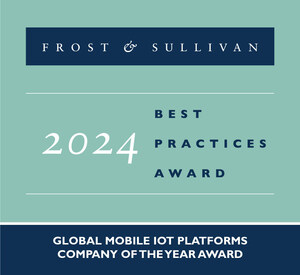Higher Production of Electric Vehicles Expands Revenue Opportunities for Telematics Service Providers
Partnerships between OEMs and telematics service providers to widen application scope of the technology, finds Frost & Sullivan
LONDON, Nov. 5, 2019 /PRNewswire/ -- With global sales of electric vehicles (EVs) forecast to rise to about 30 million units by 2025, connectivity solutions like telematics are expected to grow in application scope. New telematics systems from Hyundai's Ioniq and Kia's Niro already provide vehicle charging information, charging station locations, charger availability, and connection compatibility. The new 4G Long-Term Evolution (LTE) is opening up additional opportunities by enabling remote services, over-the-air (OTA) updates, and advanced diagnostics. The number of connected cars with embedded telematics is likely to increase from 23 million in 2018 to 65 million in 2025.
Photo - https://mma.prnewswire.com/media/1023454/Telematics.jpg
"With the rising popularity of connected services among fleet owners, telematics has become a key differentiator for OEMs. Telematics is also helping OEMs strengthen their brand, converting one-time sales into ongoing service-centred relationships," said Anubhav Grover, Mobility Research Analyst. "For instance, Honda has launched its SmartCharge Beta Program, which integrates a vehicle telematics system with the city grid, thus providing users with incentives to charge their EVs when the electricity demand is low."
Frost & Sullivan's Analysis of Embedded Telematics in the Automotive Industry, Forecast to 2025 looks at the strategies, competitive landscape, business models, and future focus areas of OEMs, telematics service providers, and technology companies. It examines market trends, potential market opportunities for participants in the embedded telematics space and strategic imperatives for market participants.
For further information on this analysis, please click here.
"With greater vehicle autonomy and Vehicle-to-Vehicle (V2V) connectivity, participants have evolved from being mere telematics service providers to being technology innovation partners," noted Grover. "Furthermore, with connected cars generating greater volumes of data, OEMs/data aggregators will need to transform from a subscription model to a customised pricing- and revenue-sharing model."
In addition to developing novel business models, OEMs can gain growth opportunities by:
- Establishing partnerships with start-ups/platform companies.
- Bundling connected services and selling aggregated vehicle data from connected cars.
- Moving towards platform (hardware and software) consolidation by 2025. This will result in a better user experience as vendors will start focusing on predictive analytics and enhancing the software interface.
- Making the most of new carrier-agnostic eSim technology, which will help simplify logistics and optimise costs.
- Collaborating with technology suppliers to provide integrated OTA upgradeability of the software across disparate systems in the automotive cockpit.
Analysis of Embedded Telematics in the Automotive Industry, Forecast to 2025 is part of Frost & Sullivan's global Future of Vehicles Systems and Technologies Growth Partnership Service program.
About Frost & Sullivan
For over five decades, Frost & Sullivan has become world-renowned for its role in helping investors, corporate leaders, and governments navigate economic changes and identify disruptive technologies, Mega Trends, new business models and companies to action, resulting in a continuous flow of growth opportunities to drive future success. Contact us: Start the discussion.
Analysis of Embedded Telematics in the Automotive Industry, Forecast to 2025
MDF0-13
Contact:
Kristina Menzefricke
T: +44 (0) 208 996 8589
E: [email protected]
http://ww2.frost.com






Share this article